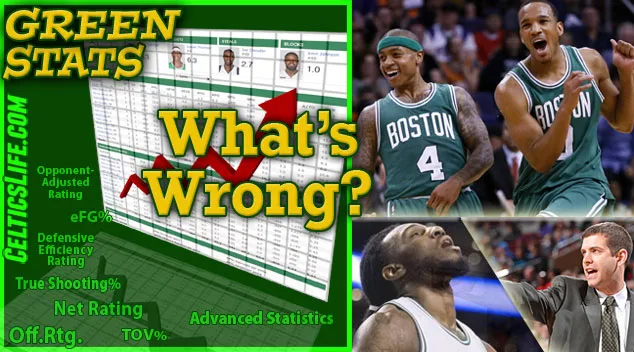Is Pace the problem behind the Celtics' offensive woes?
The Celtics' average pace — possessions per game — has been significantly higher than the NBA average this season. As of Jan 8, the Cs are averaging 98.0 possessions per game, 4th highest in the league. (League average = 95.6.)
According to Brad Stevens, this is by design. The Cs' general offensive game plan is to outhustle opponents, make em work harder than they want to, and capture easy points in transition as often as possible.
In this way, the Celts hope to counterbalance their relative dearth of raw offensive firepower, and win some games.
Sounds like a sound plan.
Problem is: the Celtics' pace is slipping. And that slippage is accelerating lately — where "lately" seems to correspond suspiciously closely to their recent offensive struggles.
As noted, the Cs' average pace this season, at 98.0, is still quite a bit higher than league average. So let's look at patterns of pace, especially recently.
As of daybreak January 7, the Celtics' average pace over their:
- last 10 games = 97.65 poss./game
- last 7 games = 96.0 poss./game
- last 5 games = 95.5 poss./game
- last 2 games = 93.6 poss./game
Here are the pace results (possessions per game) for all games so far this season (green = trend line):
And here they are for the Celtics' last 15 games:
It's clear that Boston's pace really is declining — gradually over the full season-to-date, more acutely over more-recent games.
The Big Question now is: What is the relationship between declining pace and the Cs' struggles on offense? We know that Stevens' plan was for the high pace to help the offense. Is the converse happening now that pace is declining?
–––––––––––––––
Chicken v Egg
–––––––––––––––I.e., is the Celtics' offense suffering because pace is declining? — Or is the steady reduction of pace a symptom of the Cs' poor offense, perhaps made poor by, for example, other teams learning how to effectively defend against what Boston's trying to do on that side of the court?
Intuitively, it would seem that the dropping pace numbers are directly related to the Cs' offensive woes. But is there evidence for that?
Pace and Offensive Rating:
Below are all the Cs' pace results for every game this season, alongside their Opponent-Adjusted Offensive Ratings for those same games. Focus on the two trend lines in the middle: green for pace, yellow for Opp.-Adj. Offensive Rating.
The remarkable thing about the above graph is how closely the two trend lines follow each other. Their slopes are virtually identical. As pace has trended downward, so has the offensive rating (OAR).
Here is the same graph for the Cs' last 15 games:
In both graphs, the two trend lines for Pace and Opponent-Adjusted Offensive Rating (green and yellow straight lines running across the middle) run effectively in parallel, downward.
This movement in unison strongly suggests a direct correlation between pace and the offense. I.e., the Cs' pace dropoff appears directly related to their struggles in implementing an effective offense.
–––––––––––––––
Bottom line:
–––––––––––––––Though it seems likely that the drop in the Cs' pace of play is directly related to their offensive problems, we can't know that one thing CAUSES the other unless we test it. It's still possible that pace has been dropping because the offense is simply unable to get itself going, unable to get those transition points — which would perforce result in a slower pace.
The best way to test this is to play some actual NBA games where the team focuses on assuring a high pace number. If the pace is successfully pushed up in a few such games, we should be able to see if that makes a significant difference in offensive efficiency, or not.
This is something the Celtics need to figure out ASAP. Because right now, this season is teetering on the brink of irrelevancy, pushed there by the team's wholly ineffectual offense. The Cs need to figure out why this is happening. Either that, or start changing the roster. (Or both.) Complacency at this point should be unacceptable, as it would almost certainly lead directly to a lost season — another year sacrificed in the name of "rebuilding."
–––––––––––––––––––––––––
Green Stats runs after Celtics games, right here, usually within ~ 1 to 20 hours of the final horn.
–––––––––––––––––––––––––
Efficiency ratings source for comps: Basketball-reference.com. Misc: RealGM.com. (Note: Our formulas for pace and efficiency ratings are similar to those used by these sites, and most others. NBA.com's numbers will differ, as they use different formulas.)
For an intro to the advanced stats used in Green Stats, see: Green Stats: Intro to advanced stats +...
Follow DRJ on Twitter @DRJ_CsNStats






















